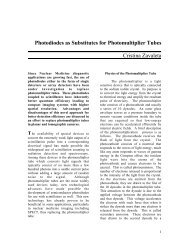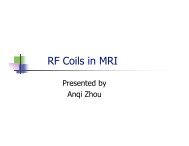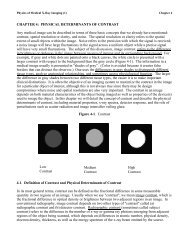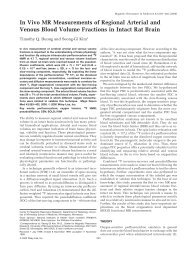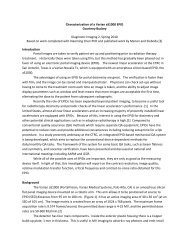PET/CT Imaging Artifacts
PET/CT Imaging Artifacts
PET/CT Imaging Artifacts
Create successful ePaper yourself
Turn your PDF publications into a flip-book with our unique Google optimized e-Paper software.
<strong>PET</strong>/<strong>CT</strong> <strong>Imaging</strong> <strong>Artifacts</strong><br />
BY<br />
SHYAM<br />
POKHAREL<br />
Graduate Student<br />
University Of Texas Health Science Center At San<br />
Antonio
Outline<br />
Introduction of <strong>PET</strong>/<strong>CT</strong><br />
Transmission based attenuation correction<br />
in <strong>PET</strong><br />
<strong>CT</strong> based attenuation correction in <strong>PET</strong><br />
<strong>Artifacts</strong> with <strong>CT</strong> based attenuation<br />
correction<br />
Summary
Introduction to <strong>PET</strong>/<strong>CT</strong><br />
New imaging modality<br />
Integrates functional <strong>PET</strong><br />
and structural <strong>CT</strong><br />
The fusion image<br />
improves a lot in lesion<br />
localization and<br />
interpretation accuracy<br />
<strong>CT</strong> data are used for<br />
attenuation correction for<br />
<strong>PET</strong> imaging
Transmission based attenuation<br />
Need some kind of<br />
rod or pt sources<br />
Perform blank scan<br />
Perform transmission<br />
scan with patient in<br />
the gantry<br />
Find attenuation of<br />
signal wrt blank scan<br />
correction in <strong>PET</strong>
<strong>CT</strong> BASED ATTENUATION CORRE<strong>CT</strong>ION<br />
<strong>CT</strong> images are used for attenuation<br />
correction of the <strong>PET</strong><br />
Reduce the total scan time<br />
<strong>CT</strong> attenuation coefficients of different<br />
tissues are mapped to respective <strong>PET</strong><br />
energies (511Kev)<br />
Generates <strong>PET</strong> attenuation correction map<br />
The mapping is unique
Image Acquisition<br />
<br />
<br />
<br />
Starts with <strong>CT</strong> scout scan followed by <strong>CT</strong> Scan and <strong>PET</strong> scan<br />
<strong>PET</strong> data are reconstructed using <strong>CT</strong> images for attenuation<br />
correction<br />
<strong>CT</strong>, <strong>PET</strong> and Fused images are displayed side by side
<strong>Imaging</strong> <strong>Artifacts</strong><br />
Metallic Implants<br />
Respiratory Motion<br />
<strong>CT</strong> Contrast Media<br />
Truncation
Metallic <strong>Artifacts</strong><br />
Dental filling, hip prosthetics,<br />
chemotherapy ports<br />
Create high <strong>CT</strong> numbers<br />
Generate streaking artifacts
Metallic <strong>Artifacts</strong><br />
1 (A) streaking artifacts (B)<br />
High <strong>CT</strong> numbers<br />
mapped to <strong>PET</strong> (C) <strong>PET</strong><br />
images w/o attenuation<br />
correction<br />
2 (A) Metal ring on left<br />
breast of patient<br />
(arrow),( B) Falsely<br />
increased radiotracer<br />
uptake on <strong>PET</strong> (C) <strong>PET</strong><br />
image w/o attenuation<br />
correction .
Respiratory Artifact<br />
Most prevalent Artifact<br />
Due to different chest position in <strong>CT</strong> and<br />
<strong>PET</strong><br />
<strong>CT</strong> is acquired during specific stage of<br />
breathing cycle<br />
<strong>PET</strong> is acquired during free breathing<br />
So <strong>PET</strong> final image is average of many<br />
breathing cycles
Respiratory <strong>Artifacts</strong><br />
The most common is<br />
Curvilinear cold areas<br />
artifact (arrow)<br />
Profound effect for<br />
proven liver lesions<br />
Liver lesion appears<br />
at the base of lung(A)<br />
Without attenuation<br />
correction (B)
Contrast media Arifacts<br />
Contrast agents like iodine, barium sulfate<br />
are used in <strong>CT</strong><br />
Affects <strong>PET</strong> images qualitatively and<br />
quantitatively like metallic implants<br />
High concentration of contrast causes high<br />
<strong>CT</strong> numbers<br />
Results in high <strong>PET</strong> attenuation<br />
coefficients<br />
Overestimation of tracer uptake
Contrast media Arifacts<br />
(A) 61 years old lung cancer patient with barium ingested 1<br />
d before <strong>PET</strong>/<strong>CT</strong><br />
(B) High <strong>CT</strong> numbers overcorrect attenuation of <strong>PET</strong> data<br />
(C) Image without attenuation correction (no increased<br />
uptake seen)
Truncation Artifact<br />
Due to difference in field of view <strong>CT</strong> (50<br />
cm) and <strong>PET</strong> (70cm)<br />
Frequently seen in large patients<br />
The extended part beyond field of view in<br />
<strong>CT</strong> is truncated<br />
Results in no attenuation correction values<br />
for the corresponding region in <strong>PET</strong><br />
emission data
Truncation Artifact<br />
(A) <strong>CT</strong> images appears truncated at sides<br />
(B) Biased <strong>PET</strong> attenuation corrected image
Summary<br />
<strong>PET</strong>/<strong>CT</strong> is faster than dedicated <strong>PET</strong><br />
It is better in the sense it uses low-noise<br />
<strong>CT</strong> scan for attenuation correction<br />
Increases image quality<br />
Increases accuracy of diagnosis<br />
<strong>Artifacts</strong> are easily discernable, all you<br />
have to have is <strong>PET</strong> image without<br />
attenuation correction and <strong>CT</strong> image side<br />
by side
References<br />
1 Waheela Sureshbabu, , Journal of nuclear Medicine Technology volume 33, Number 3,<br />
2005 156-161<br />
2 Hany TF, Steinert HC, Goerres GW, Buck A, von Schulthess GK. <strong>PET</strong> diagnostic<br />
accuracy: improvement with in-line <strong>PET</strong>-<strong>CT</strong> system—initial results. Radiology.<br />
2002;225:575–581<br />
581<br />
Goerres GW, Ziegler SI, Burger C, Berthold T, von Schulthess GK, Buck A. <strong>Artifacts</strong><br />
at <strong>PET</strong> and <strong>PET</strong>/<strong>CT</strong> caused by metallic hip prosthetic material. Radiology.<br />
2003;226:577–58<br />
58<br />
Antoch G, Freudenberg LS, Egelhof T, et al. Focal tracer uptake: a potential<br />
artifact in contrast-enhanced dual-modality <strong>PET</strong>/<strong>CT</strong> scans. J Nucl Med.<br />
2002;43:1339–1342<br />
1342<br />
Dizendorf E, Hany TF, Buck A, von Schulthess GK, Burger C. Cause and<br />
magnitude of the error induced by oral <strong>CT</strong> contrast in <strong>CT</strong>-based attenuation<br />
correction of <strong>PET</strong> emission studies. J Nucl Med. 2003;44:732–738<br />
738<br />
Positron emission tomography, encyclopedia<br />
Jonathan Carney, Ph.D, AAPM 46 th Annual meeting July 25-29, 2004<br />
Presentation entitled “<strong>PET</strong>/<strong>CT</strong> Attenuation Correction and Image Fusion<br />
“
ANY QUESTIONS?



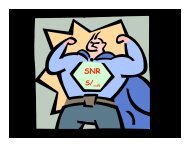


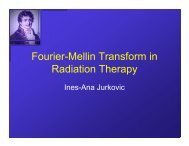
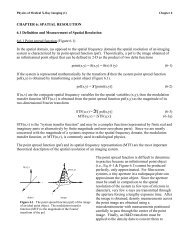
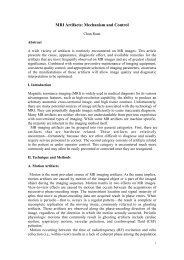
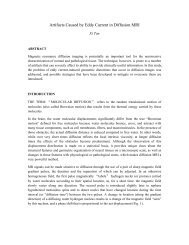
![Methods for preventing Motion Artifacts in MRI [pdf]](https://img.yumpu.com/28806288/1/190x146/methods-for-preventing-motion-artifacts-in-mri-pdf.jpg?quality=85)
